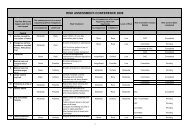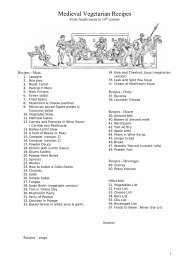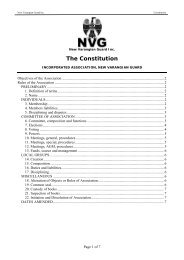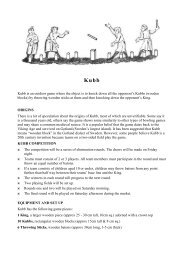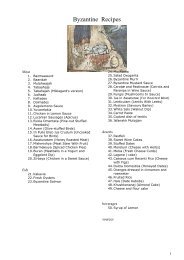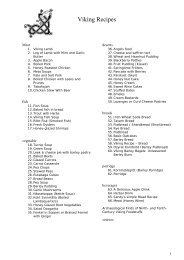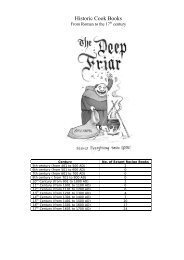Anglo saxon Recipes This is a recipe that
Anglo saxon Recipes This is a recipe that
Anglo saxon Recipes This is a recipe that
You also want an ePaper? Increase the reach of your titles
YUMPU automatically turns print PDFs into web optimized ePapers that Google loves.
Beer /Ale<br />
beverages<br />
Beer <strong>is</strong> a very simple drink to produce. In its simplest form it <strong>is</strong> quick to produce, but almost<br />
unpalatable to modern tastes!<br />
Before I describe how the beer <strong>is</strong> made, here are a few background details:<br />
Correctly any beer made in our period should, in fact, be referred to as Ale. The word Beer<br />
used to refer to a brew containing hops, or Beor (honey). Hops were not used in th<strong>is</strong> country<br />
until much later. The first record of their use being 1236 A.D.<br />
Malt.<br />
Mash<br />
Gruit<br />
Yeast<br />
<strong>Th<strong>is</strong></strong> <strong>is</strong> the name given to the cereal (nearly all cereals can be used in brewing) once it<br />
has been "Malted". Malting <strong>is</strong> the process by which the grain <strong>is</strong> soaked over a few days<br />
and then laid out to dry. Once it starts to germinate, it <strong>is</strong> very roughly crushed or<br />
ground so <strong>that</strong> the husks are just starting to break away from the grains. <strong>Th<strong>is</strong></strong> ensures<br />
<strong>that</strong> as much as possible of the food contained <strong>is</strong> available for fermenting..<br />
No not the potato variety! Mash <strong>is</strong> the name given to the mix of malt and gruit which<br />
are allowed to ferment together.<br />
The name given to the flavouring. It <strong>is</strong> well known <strong>that</strong> nowadays we use almost<br />
exclusively the hop flavour for beer, but in Saxon times many other things were used,<br />
such as: Bog Myrtle, Honey, Yarrow, and Cinnamon, to name but a few. Sometimes a<br />
mix or blend was used often incorporating a blossom. Blossoms can add additional<br />
yeast to the brew.<br />
Normally yeast would not be added to the "first brew", instead , it would rely on natural<br />
airborne yeast to "infect" it. Before final straining of the brew any yeast <strong>that</strong> had grown<br />
would be removed and added to the next brew at the start of the next fermentation.<br />
Some extra yeast can be obtained from certain gruits. The purpose of yeast in the brew<br />
<strong>is</strong> to create alcohol. As some of you may have noticed th<strong>is</strong> <strong>is</strong> a particularly popular<br />
ingredient in any beer.<br />
How to Brew<br />
Using, if possible, a copper cauldron as it adds a bit of flavour, simmer (bring it to the boil and<br />
keep it gentle boiling) the malt in soft water (hard waters can alter the taste of some ales) for<br />
around two hours (some brews may need more, some less). Transfer to a wooden barrel or<br />
similar container and leave to cool down to a temperature of around 16°C (around 60°F).<br />
Add the gruit and leave to ferment in a warm location. After about six to eight hours cover with<br />
a thin cloth. Apart from the occasional stir there <strong>is</strong> no need at all to touch the mash and<br />
looking at it every five minutes will not increase the speed of fermentation!<br />
Leave to ferment for at least 24 hours but no more than three days. The final strength of the<br />
beer will be affected by the length of time the brew <strong>is</strong> left. (the alcoholic content of Saxon<br />
beers was probably low, but the point of the process was to produce a safe and pleasant drink<br />
with any intoxication being a bonus) . Other factors such as ambient temperature contribute to<br />
the end result. Now you can strain the mash. <strong>Th<strong>is</strong></strong> can be done with a fairly course sieve as a<br />
second and third straining are always needed to remove the yeast. By now you will (should)<br />
have a wooden container full of an insipid yellow<strong>is</strong>h opaque liquid and a sieve full of mash. Do<br />
not throw the mash way, as th<strong>is</strong> contains a lot of yeast and can be used to make bread.<br />
26



